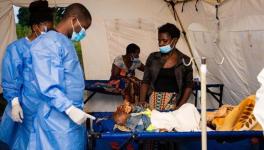COVID19: The Cells That Make Entry of the Virus Easy
With the COVID-19 pandemic, many terms whose usage was limited to the scientific community have now been familiar to the common people. One such term is the spike protein (S protein) of the coronavirus.
This S protein is like the spikes on the surface of the virus and is the most crucial part for its entry to the human cell. The strategy of the virus to make an entry is to first cling to certain receptors present on the surface of the human cells. It does so with the help of the S protein. The receptor on the human cell, in this case,s is named ACE 2.
This raises a pertinent question: are there any kinds of human cells that have plenty of the ACE 2 receptors to enable the easy entry of the virus? One’s immediate guess would be the cells in the respiratory tract. Because, the novel coronavirus primarily colonises this part of the body. It is almost with certainty that one might ascribe the nostrils to be the gateway for the virus to have access to other organs. So, the concomitant thought is: could it be the nostrils that harvest the cells with plenty of the ACE 2 receptors on it?
On April 23, a research paper published in the Nature Medicine addressed these questions and came out with findings that particular types of nasal cells have an extraordinarily high level of the receptors needed for the coronavirus. The types of cells are goblet cells and the ciliated cells. Notably, in the symptomatic COVID-19 patients, the nasal swabs have more viral load than the swabs from the throat. This could be attributable to more prevalence of the proteins (receptors) on the nasal cells.
The study analysed the RNA expression data in different cells of different organs. These included cells of the lungs, nasal cavity, eye, gut, kidney and the liver. The researchers tried to zero down to particular cell types that make overwhelming availability of the proteins needed to ease the viral entry as well as their replication. Waradon Sungnak, the lead author of the study quoted to have said, “We found that the receptor protein -- ACE2 -- and the TMPRSS2 protease that can activate SARS-CoV-2 entry are expressed in cells in different organs, including the cells on the inner lining of the nose. We then revealed that mucus-producing goblet cells and ciliated cells in the nose had the highest levels of both these COVID-19 virus proteins, of all cells in the airways. This makes these cells the most likely initial infection route for the virus.”
Along with ACE2, there is another protein that is associated with the initial entry of the virus to human cells. This is called the TMPRSS2 protein. This protein is a protease. Proteases are capable of hydrolyzing peptide bonds in proteins.
The S protein has two domains (parts) in it—the S1 and the S2 and both of them have specified functions that work in the viral entry to the host cell. The S1 domain functions to cling to the typical receptor, while the S2 domain helps in fusion with the membrane of the host cell. What it means is, through the S1 domain the virus finds the suitable receptor to cling on and through the S2 domain it tightly binds with the host cell membrane. Now, to be effective, the S protein needs to be cleaved for the separation of S1 and S2 domains. The TMPRSS2 protein present in the host cell (human cell) does this cleaving. This makes the TMPRSS2 protein an essential ingredient in the viral entry to the host cell.
The researchers in the study also analysed the cell types that have plenty of TMPRSS2 protein in it. The ACE2 receptors and the TMPRSS2 proteins combined make the viral entry to our cells easy. It turned out that the goblet and the ciliated cells in the nasal cavity produce both the ACE2 and TMPRSS2 proteins in plenty. In fact, these nasal cells have the highest levels of the viral entry proteins out of all cell types that were studied in the paper.
These two key entry proteins were also found in the cornea of the eye and intestinal cells. Probably, this is the explanation for “ocular phenotype observed in a small portion of COVID-19 patients with the potential of spread through the nasolacrimal duct”—reads the study.
This study is the result of the use of the Human Cell Atlas (HCA) data. The HCA is a global consortium established in 2016 where a complete atlas of different human cell types is being constructed.
Get the latest reports & analysis with people's perspective on Protests, movements & deep analytical videos, discussions of the current affairs in your Telegram app. Subscribe to NewsClick's Telegram channel & get Real-Time updates on stories, as they get published on our website.
























